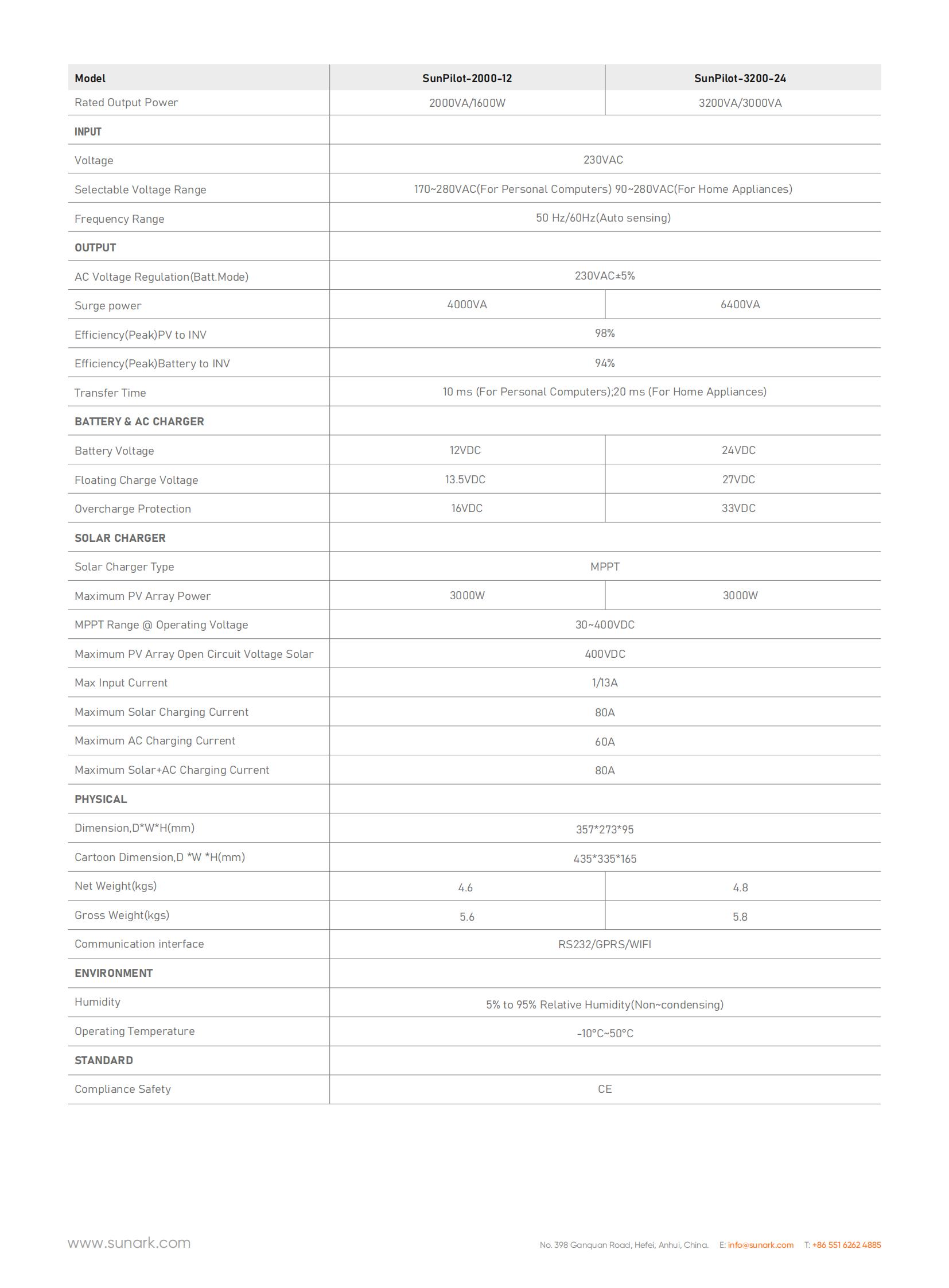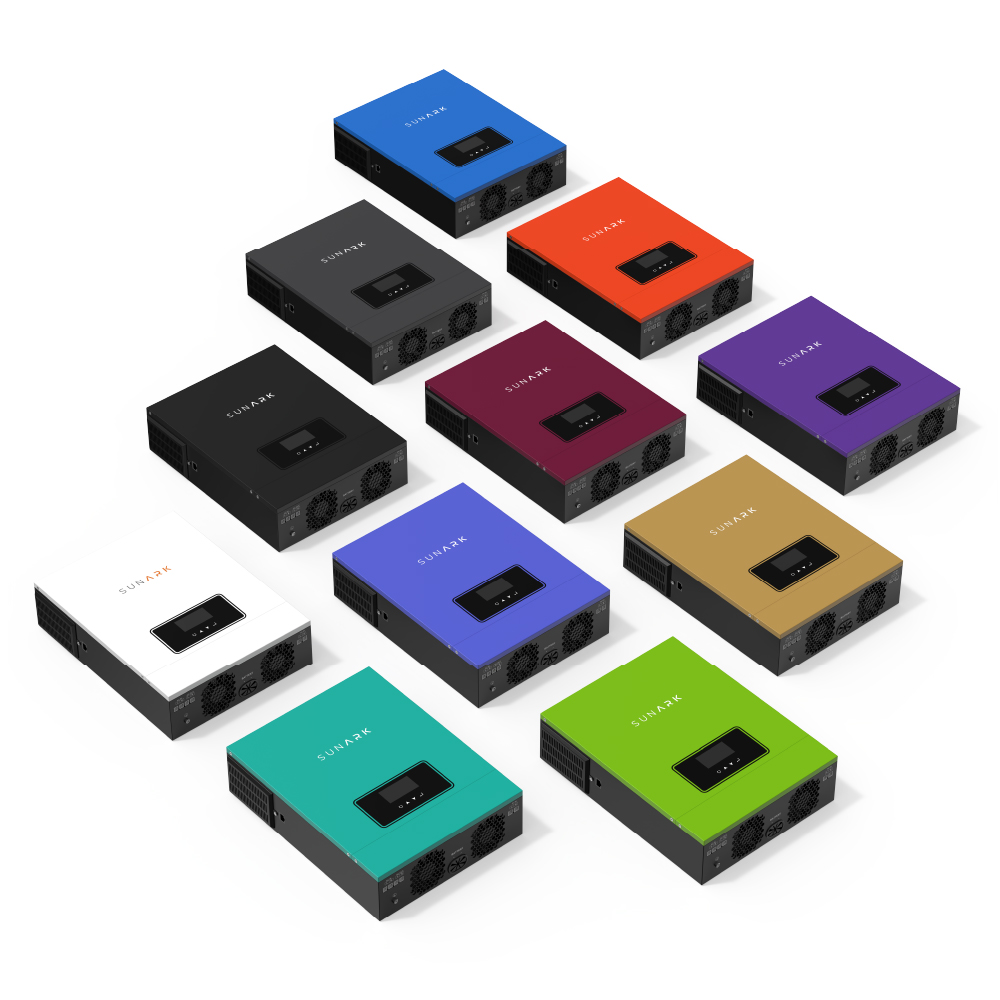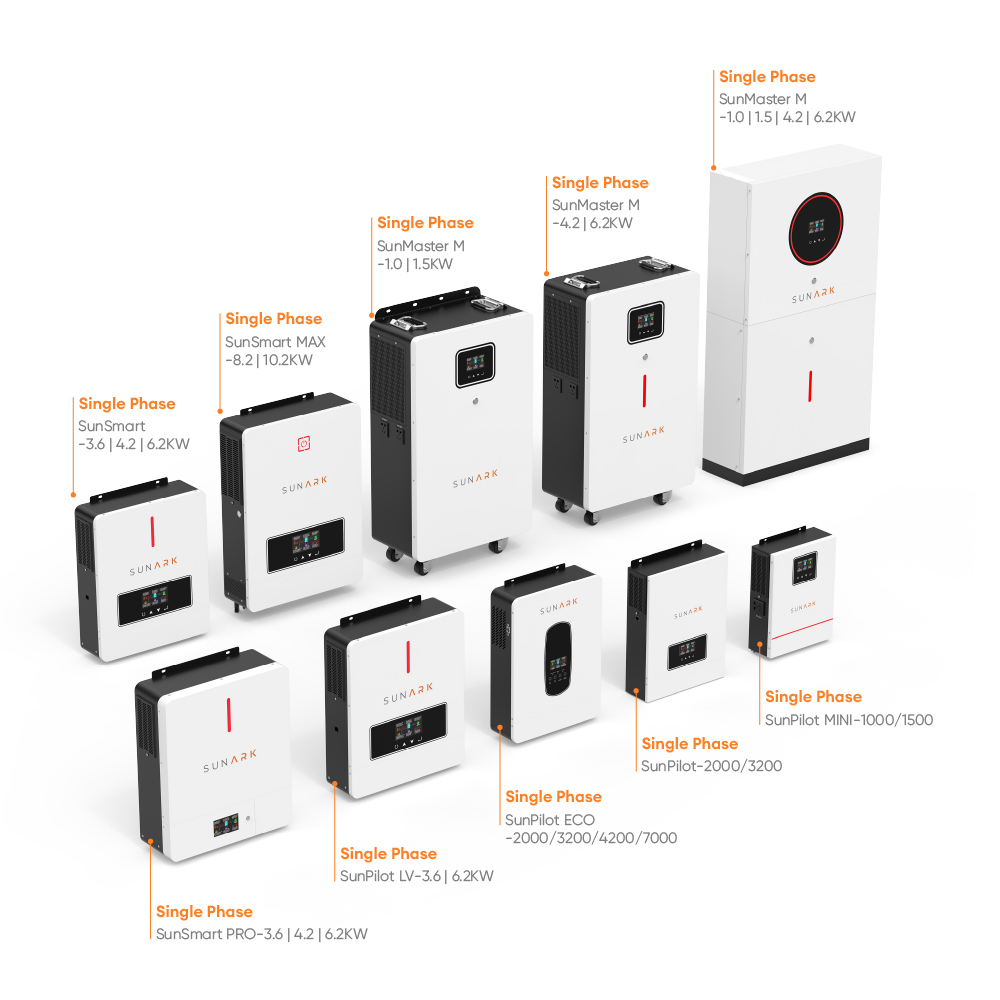Um inversor híbrido combina a funcionalidade de um inversor tradicional ligado à rede e um inversor fora da rede baseado em bateria. Ele permite conectar seus painéis solares à rede e também armazenar o excesso de energia em baterias para uso em períodos de baixa geração solar ou durante queda de energia. Os inversores híbridos são comumente usados em instalações solares residenciais e comerciais para aumentar o autoconsumo e a independência energética.
marca:
SunArk:
SunArk SunPilot-3200-24 3000W 30~400VDC 3200VA 230VAC±5%A folha de dados do SunArk SunPilot série 3200VA abaixo:


Cores diferentes para opção:

Um inversor solar híbrido é um tipo avançado de inversor que combina as funcionalidades de um inversor solar tradicional e de um inversor de bateria. Sua principal função é gerenciar e otimizar o fluxo de eletricidade entre painéis solares, baterias e a rede elétrica em um sistema de energia solar híbrido.
As principais funções de um inversor solar híbrido incluem:
Conversão de energia solar: O inversor solar híbrido converte a eletricidade DC (corrente contínua) produzida pelos painéis solares em eletricidade AC (corrente alternada) que pode ser usada para alimentar eletrodomésticos e alimentar a rede elétrica.
Carregamento da bateria: Em um sistema solar híbrido, o excesso de energia solar não consumida imediatamente é armazenado em baterias. O inversor híbrido gerencia o carregamento das baterias regulando a quantidade de energia dos painéis solares utilizada para carregar as baterias.
Descarregamento da bateria: Quando a eletricidade é necessária após o pôr do sol ou durante uma queda de energia, o inversor híbrido permite que a energia armazenada nas baterias seja convertida novamente em eletricidade CA e usada para alimentar os eletrodomésticos. Ele alterna perfeitamente entre energia da rede, energia da bateria e energia solar com base na disponibilidade e demanda de eletricidade.
Interação com a rede e medição líquida: Em sistemas solares híbridos, o excesso de energia solar produzido durante o dia pode ser realimentado na rede elétrica, e o inversor híbrido gerencia a interação entre a rede e o sistema solar. Permite a medição líquida, onde qualquer excesso de eletricidade gerada é exportada para a rede e o proprietário recebe créditos ou redução nas contas de eletricidade.
Mudança de carga e gerenciamento de energia: O inversor híbrido otimiza o uso de energia solar e armazenamento de bateria com base em vários fatores, como demanda de energia, hora do dia, nível de carga da bateria e tarifas de eletricidade. Gere de forma inteligente o fluxo de eletricidade para dar prioridade à utilização da energia solar e da energia armazenada sempre que possível, reduzindo a dependência da eletricidade da rede e otimizando o consumo de energia.
Monitoramento e controle: Os inversores solares híbridos geralmente incluem recursos de monitoramento e controle que permitem aos usuários monitorar o desempenho do sistema solar, o status da bateria, a produção e o consumo de energia. Alguns inversores também oferecem recursos de monitoramento e controle remoto por meio de aplicativos de smartphones ou plataformas online.
Overall, the function of a hybrid solar inverter is to efficiently integrate solar power, battery storage, and grid electricity to maximize energy self-consumption, load flexibility, and overall system efficiency in a hybrid solar power system.

In a solar system, a hybrid inverter plays a crucial role in managing the flow of electricity between the solar panels, batteries, and the electrical grid. Here's how a hybrid inverter typically works in a solar system:
Solar Power Conversion: The hybrid inverter receives the DC electricity produced by the solar panels and converts it into usable AC electricity. This process is called inversion. The inverter ensures that the AC electricity generated matches the requirements of the appliances and electrical loads in the house.
Energy Consumption: The hybrid inverter prioritizes the use of solar electricity to power the household appliances and meet the immediate energy demand. It will direct the solar power to the loads within the house, reducing or eliminating the need to draw electricity from the grid.
Battery Charging: If there is excess solar power that is not immediately consumed, the hybrid inverter manages the charging of the batteries. It regulates the amount of energy directed from the solar panels to the batteries to ensure optimal charging without overcharging.
Battery Discharging: When electricity is required at a time when solar energy is not available, such as during nighttime or a power outage, the hybrid inverter draws electricity from the batteries. It converts the DC electricity stored in the batteries back into AC electricity, allowing it to power the household appliances.
Grid Interaction: In a hybrid solar system, the hybrid inverter enables interaction with the electrical grid. If there is surplus solar energy that cannot be immediately consumed or stored in the batteries, the inverter can feed the excess electricity back into the grid. This allows the homeowner to earn credits for the excess energy produced, usually through a net metering arrangement.
Monitoring and Control: Hybrid inverters often include monitoring and control features that provide real-time data on energy production, consumption, battery status, and system performance. Users can monitor their system's performance, adjust settings, and access historical data to optimize energy usage.
Seamless Switching: The hybrid inverter ensures seamless and automatic switching between different power sources. It can monitor the energy availability, prioritize the use of solar power and battery storage, and switch to drawing electricity from the grid when necessary. The transition between power sources is typically smooth and uninterrupted.
No geral, o inversor híbrido atua como o hub central de um sistema solar, gerenciando a conversão, o consumo, o armazenamento e a distribuição de eletricidade para maximizar a eficiência energética e a autossuficiência. Otimiza o uso da energia solar, aproveita a energia da rede e carrega e descarrega as baterias de forma eficiente, proporcionando um fornecimento de eletricidade confiável e econômico para o.